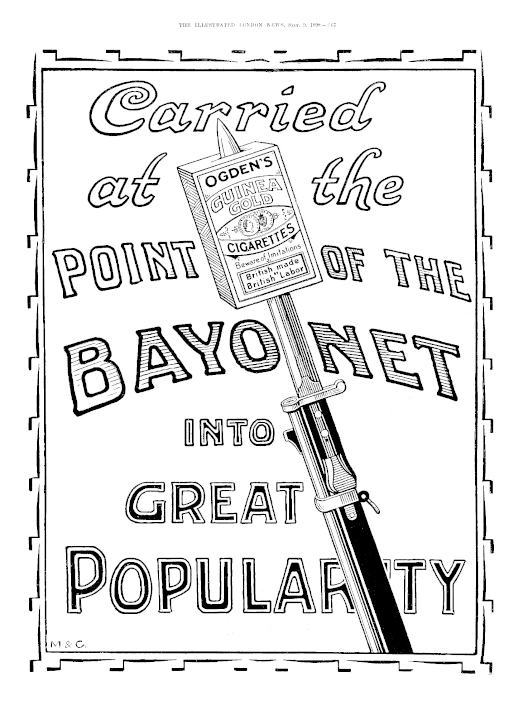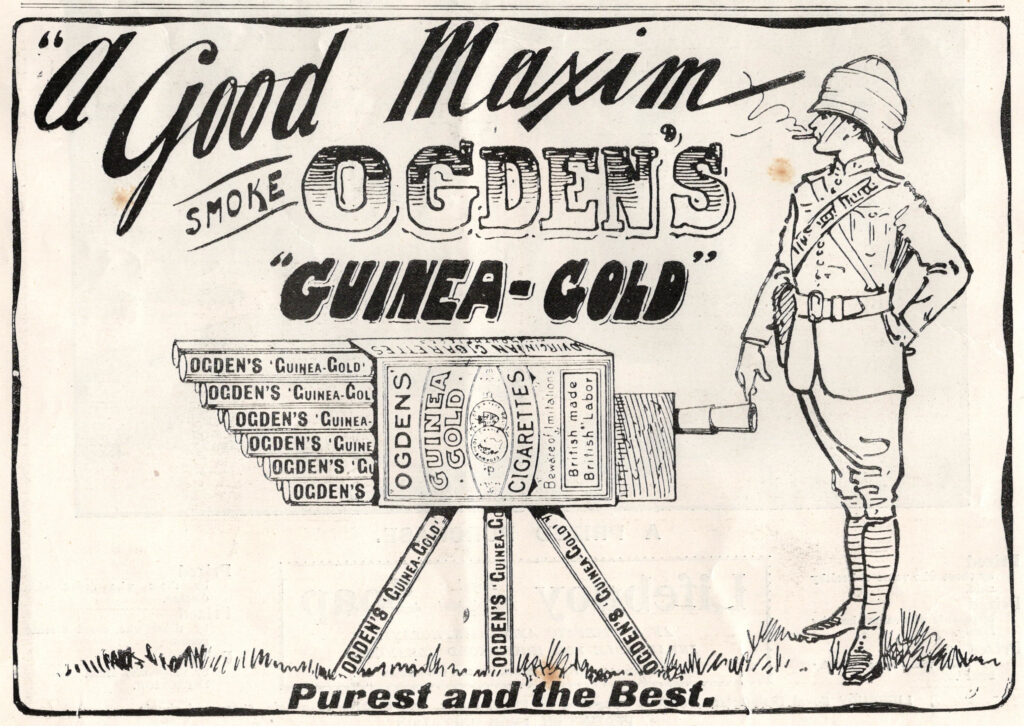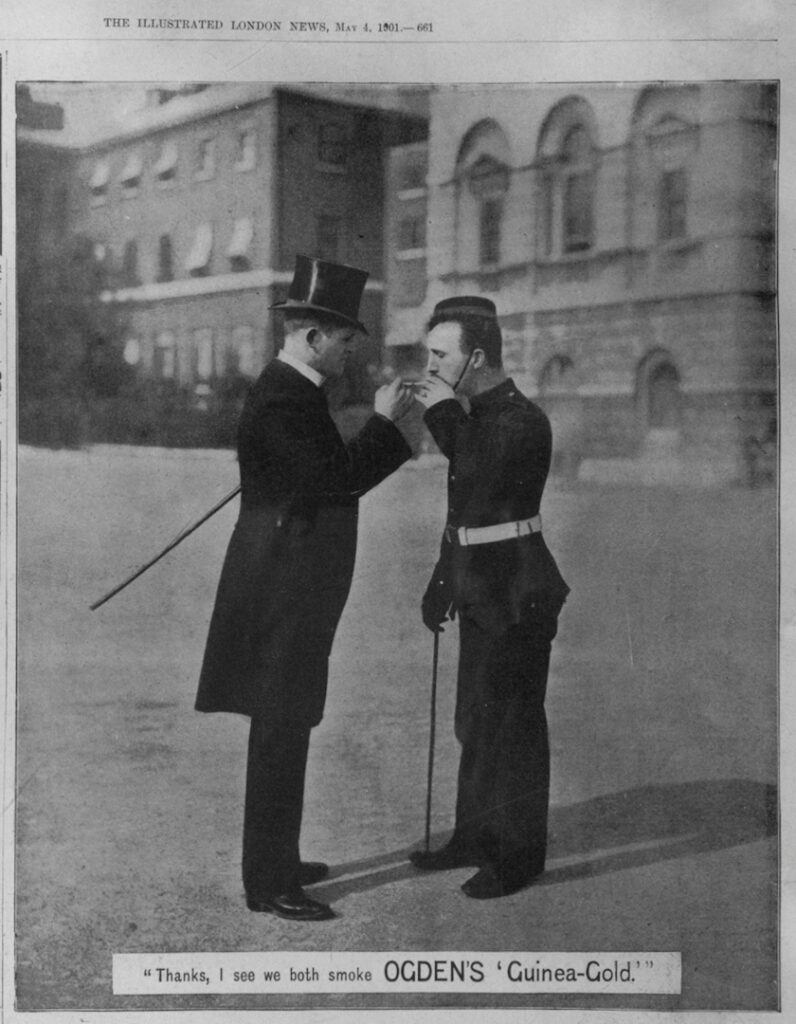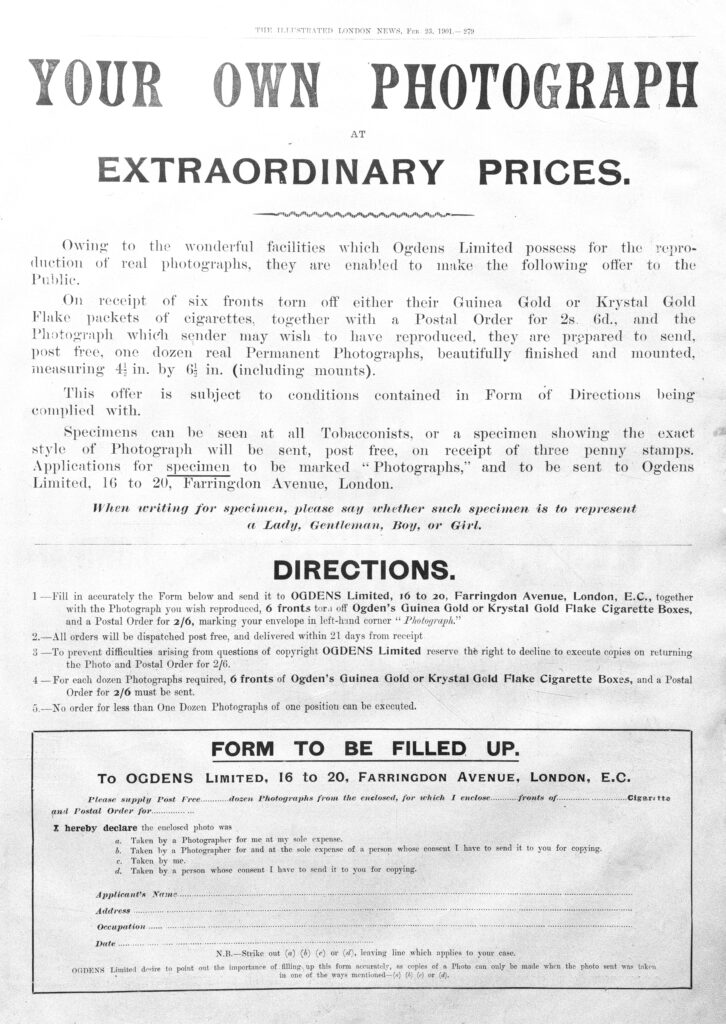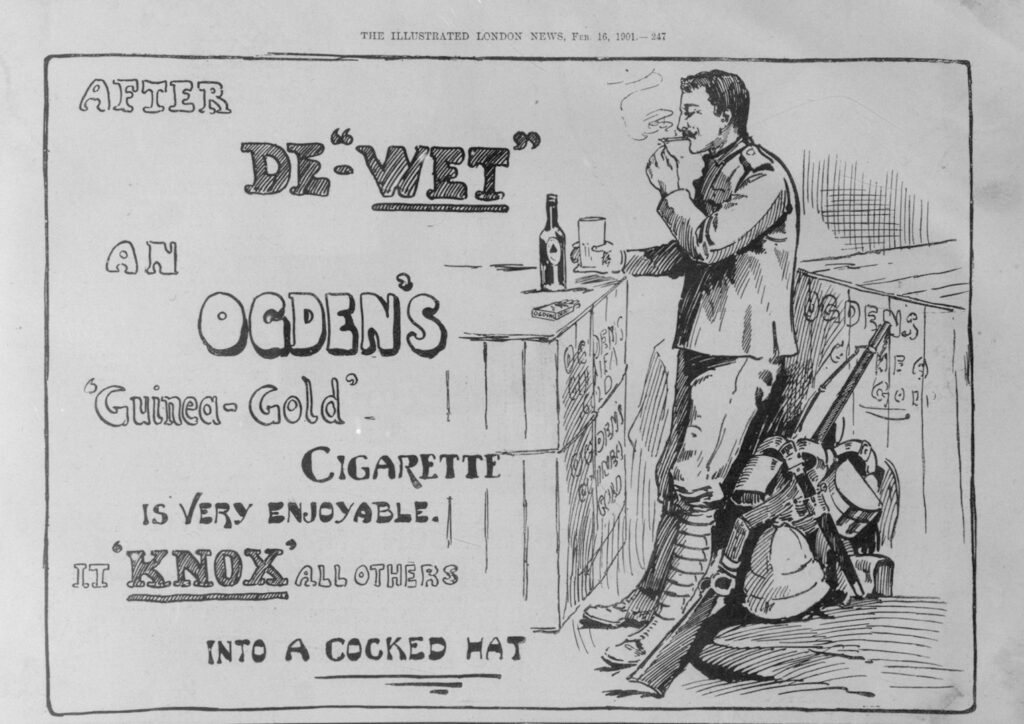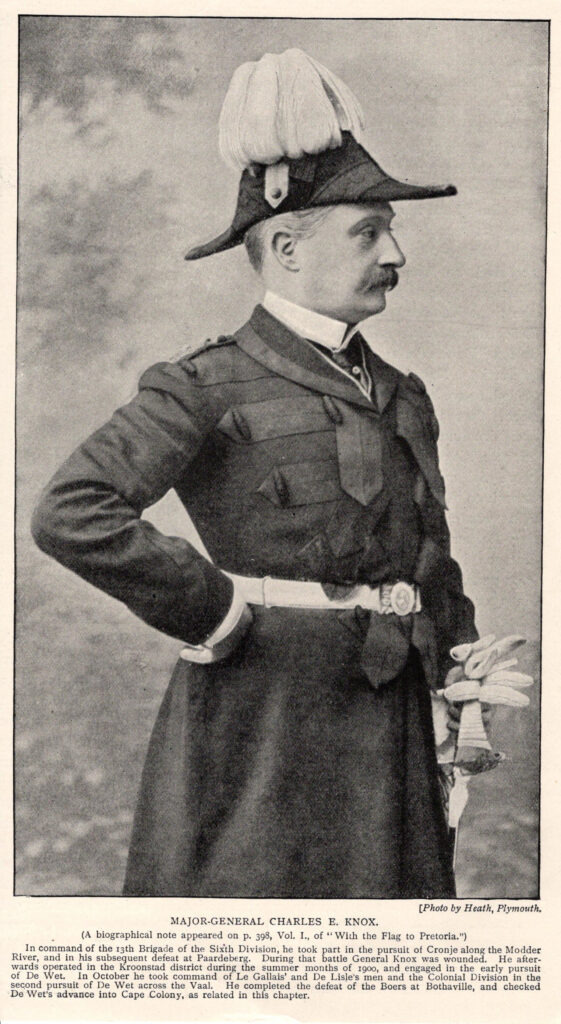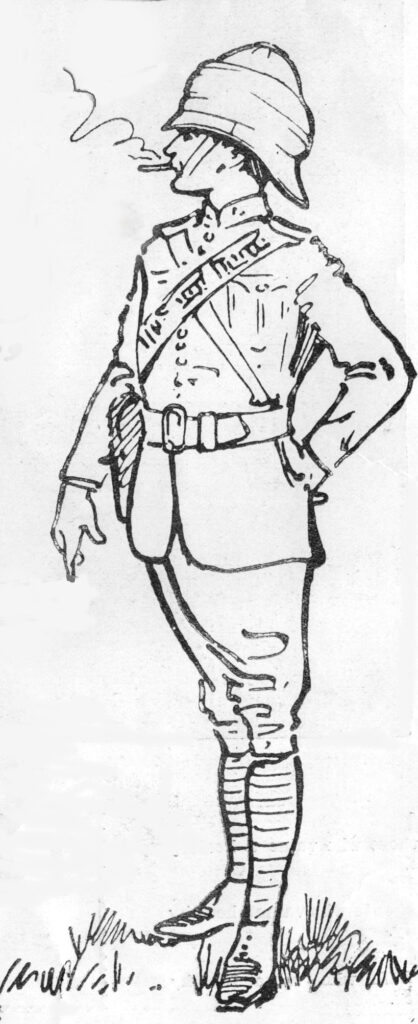
Action stations – September 1899
Ogden’s military advertising campaigns of the Boer war launched in the Illustrated London News magazine (hereafter ILN) of 9 September 1899, a month before the official declaration on 11 October.
After an initial foray in the early 1890s, Ogden’s had established a regular place in the ILN’s advertising section. Their bold, eye-catching, often humorous illustrations with snappy word play dominantly labelled Ogden’s “Guinea Gold” appeared most weeks. Occasional topical references appeared, but Ogden’s were still courting their market, so nothing too controversial. September’s bayonet driven advertisement is an ‘interesting’ choice especially to modern punters, the ghostly echo of Dad’s Army Corporal Jones’s catch phrase in mind. As mentioned in the Smoking Gun Gallery (no.2) it is not the most glamorous of weapons and has generally been used to promote aggression in military training. A strange image then to capture the popular mood and frankly not their most compelling.

We’ve got the Maxim! – January 1900
By January 1900 reality had struck. The Boers fighting for their homes and livelihoods were proving to be stubborn opponents and the British expeditionary force had to call on re-enforcements from home and territories under British rule. Although there was no conscription, volunteer corps were actively recruiting throughout the country.
Ogden’s, ever keen to celebrate British prowess, boost morale and engage their public, revived a 3 year-old advertisement and tag line – ‘A Good Maxim smoke OGDEN’S “GUINEA-GOLD” ‘in Saturday 13 January’s ILN. Discarding 1897’s all action image, they substituted a visual pun more in keeping with their established humorous approach. While both advertisements feature the same components – a Maxim gun and soldier – they are very differently visualized. The 1900’s kaki clad, pith-helmeted soldier stands smoking beside Ogden’s fully branded rather cartoonish version of a Maxim gun created from their “Guinea-Gold” cigarette packet and its contents. On closer inspection the image has a composite look, the military figure perhaps added to give context without offending the market, many of whom had family engaged in the fighting. His 1897 predecessor, operating the gun amidst billowing smoke, too realistic for comfort.
Published ILN January 3, 1900 (p.60)
Commandeering the smoking soldier
The pages of the ILN were filled with articles, photographs and drawings of the war, and Ogden’s introduced a topical thread in their advertising campaign for the year, interspersed with more domestic themes thereby maximizing audience retention.
January 27 1900’s advertisement combined both, with a chap in civvies offering an Ogden’s “Guinea- Gold” to a party of departing uniformed soldiers captioned “ALWAYS TO THE FRONT”. This advertisement is also distinguished in having the artist’s initials and a date – ‘R.B/1899’. Subsequent advertisements featuring scenes of service life suggest R.B’s services may have been retained. It is frustrating that the creators of so many of these images remain anonymous.
Sometimes Ogden’s advertisements – whether by luck or design – match the ILN copy they follow. One such is 10 February’s military scene of a pith helmeted cavalryman offering his slouch hatted comrade a cigarette while a cavalry column approach over the hill declaring “AN OGDEN’S “GUINEA-GOLD” CIGARETTE IS A ‘WELCOME COMRADE’ ”. A posed group photograph of officers of the first contingent of Imperial Yeomanry look steadily out at the reader from above.
Topical references were included. In March, smoking a “Guinea-Gold” offered solace to an embittered cartoon Scottish Sergeant Major bemoaning missing “Kimberley, Lady Smith & Blooming Fountain [sic]” and “Cronje”. ILN readers would recognize the names of the recently raised sieges of Kimberley and Ladysmith and appreciate the slang rendition of the Orange Free State’s capital Bloemfontein. The Boer commander Piet Cronje surrendered after defeat at the battle of Paardeberg on 27 February. He, and his wife Hettie who accompanied him on campaign, were interned as prisoners of war on St Helena in the South Atlantic Ocean. Ogden’s must have felt their advertisement spot on. They were not to know that while the full-scale military action had apparently concluded, guerilla warfare would continue for a further 2 years until 31 May 1902. Britain’s subsequent scorched earth tactics and the unthought through consequences of civilian internment incurred international and domestic censure.
Blissfully unaware of such developments, Ogden’s continued their military theme seizing the opportunity to feature a realistic scene of troops relaxing with the aid of “Guinea-Golds” helpfully labelled “ON THE ROAD TO PRAETORIA. A WELL-EARNED REST”. Each man shown determinedly puffs on his cigarette, presumably confident the resulting column of smoke will not attract Boer attention. Perhaps wishful market development too on Ogden’s part? While cigarettes would be some officer’s choice, among all ranks pipes were largely the order of the day. In May and June Ogden’s featured political cartoons directed against Boer politicians, sadly rather lost on the modern viewer. Cronje, marooned on St Helena was featured – plus telephone and cigarette – in May 19’s ad.
Ogden’s had been issuing cigarette cards since 1899, capitalizing on the collecting mania sweeping Europe at the time, and on 14 July 1900 launched a series of “60 real photographs of all the most celebrated officers at the front” in their “Guinea-Gold” packaging. The advertisement listed the featured officers. At the end of the month, direct from Bloemfontein, the Royal Army Medical Corps G Lemmon’s glowing testimonial to the usefulness of a “Golden-Guinea” advertising placard liberated from the veldt near Orange River Station featured. A pencil sketch after a photograph, shows the placard in front of the RAMC Cook House, accompanied by four chaps in their shirt sleeves dutifully puffing away.
Retreating from direct action
However, the tide was turning, and while uniformed soldiers continued to feature, the military references became more oblique. Ogden’s could not afford to alienate their consumers.
Published ILN September 1 & November 26, 1900 and May 4 1901 (p.661)
A departure from the usual drawn illustration, the staged photograph shows a top hatted City gent and pillbox hatted Grenadier Guard on Horse Guards Parade finding common ground in smoking Ogden’s ‘Guinea-Golds’. Obviously deemed successful, the advertisement ran 1 September and 26 November 1900, and again 4 May 1901.
Meanwhile, the British government seeking to capitalize on military success and secure public support for their South African policy called a general election 26 September – 24 October. Ogden’s sighting a marketing opportunity issued a series of real photographs of prominent British politicians from 6 October, along the lines of July’s front-line officers. Maximizing their general appeal, their 13 October advertisement claimed “Guinea-Golds” “ELECTED WITH ACCLAMATION BY ALL PARTIES”.
Ogden’s autumn adverts incorporating a profile figure of a fully kitted soldier standing to attention, rifle grounded, anticipate the iconic lone commemorative figure today associated with the First World War. He first appeared in 29 September’s ILN, alongside an oversized Guinea-Gold cigarette packet “BOTH KEEPING UP THEIR GREAT REPUTATION”. By 3 November both had shrunk slightly and were recaptioned “THE BRITISH PRODUCTION Have no equal in the world”.
Approaching Christmas Ogden’s offered a full-page artistic rendition “HOME FROM THE FRONT: FIGHTING THEIR BATTLES OVER AGAIN WITH OGDEN’S GUINEA-GOLD CIGARETTES” in December. A reassuringly cosy scene of evening- jacketed chaps back in Blighty deploying cigarettes as markers in their post dinner re-enactments.
Medical endorsement
To modern eyes the Lancet’s note on the “Use of Tobacco on Active Service” published 10 November 1900 (p.1365) appears incongruous. To Ogden’s it was a copywriter’s dream, ripe for sharing. Relying on graduated text rather than an eye-catching image, beneath the header “IMPORTANT TO SMOKERS” their 29 December advertisement revealed the ‘great beneficial use of tobacco by our soldiers during the Boer War’. Quoting directly from the Lancet “We are inclined to believe that used with due moderation tobacco is of value second only to food itself” they added their own conclusion ‘if tobacco is good for the soldier, it is equally so for the civilian but be sure that you smoke pure Tobacco ’. Unfortunately, the copywriters neglected to include the end of the original quotation “when long privations and exertions are to be endured” and the caveat that while the open air mitigated some of the side effects of smoking, concerns remained. Nor was mention made of the fact that the Lancet specified pipe smoking, rather than cigarettes. Nonetheless such scientific endorsement was not to be wasted and it ran again on Saturday January 12 1901.
Marshalling resources – 1901 commercialisation
Published ILN February 23, 1901 (p. 279)
Always alert to profitable opportunities, Ogden’s sought to monetarize their considerable reprographic facilities in a series of advertisements in Spring 1901 starting on February 2. They launched a public photographic copying service offering a dozen mounted 4½in x 6½in prints. Simply complete the accompanying form, collect 6 cigarette box fronts – Golden Guinea or Krystal Gold Flake accepted – and send a postal order for 2/6d plus the original photograph to their Farringdon Avenue Office. Orders dispatched post free 21 days from receipt, “Specimens on show at all Tobacconists”. The Bank of England inflation calculator suggests a modern cost of approximately £1.06 per print. Presumably this compared favourably with rates offered by local photographic studios for sending a snap to those serving in South Africa. A similar offer from Lever Brothers’ Sunlight Soap appears on p. 245 of February 16’s ILN on very much the same terms but requiring 12 sunlight soap wrappers.
Published ILN February 16, 1901 (p.247)
The soldier on active service featured again in February surrounded by “Guinea-Gold” crates, one of which has been pressed into service as his drink’s table, declaring “AFTER DE “WET” AN OGDEN’S “GUINEA-GOLD” CIGARETTE IS VERY ENJOYABLE. IT “KNOX” ALL OTHERS INTO A COCKED HAT”. Readers would enjoy the puns recalling Knox’s unsuccessful 800-mile pursuit of the Boer commander Christiaan De Wet. It continued to haunt Knox and was even mentioned in his Time magazine obituary of 14 November 1938
The final active service reference appears in the staged “humorous” photo advertisement of 13 April 1901
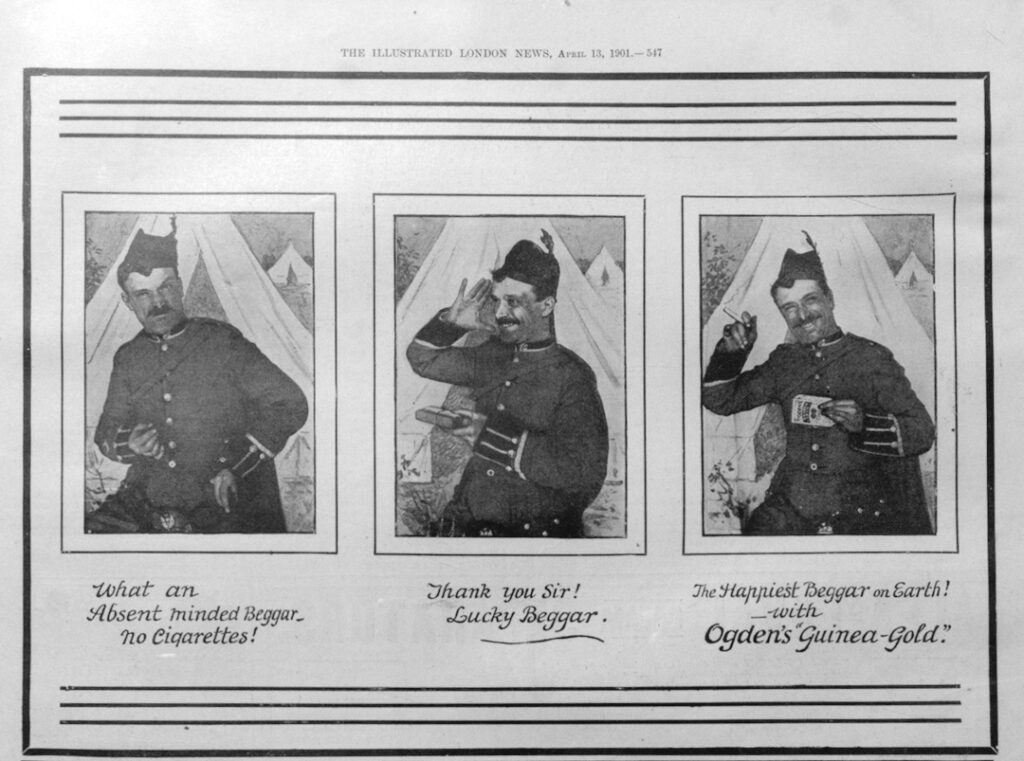
Published ILN April 13, 1901 (p.547)
Certainly not a flattering portrayal of Ogden’s market it references Kipling’s popular poem The Absent Minded Beggar. Commissioned by the Daily Mail at the outbreak of war to raise funds to support serving soldiers and their families and set to music by Sir Arthur Sullivan, it enjoyed widespread popularity throughout the war and after. It gave rise to the Absent – Minded Beggar Relief Corps and Fund, accompanying merchandise and proved an unprecedented fund-raising success.
Ogden’s also produced a civilian version, first published 26 January and repeated April 27. The tag line may have been shared, but the interpretation was not. A distracted Father working at his books quill pen in hand, sucks on his child’s bottle, while the infant puffs his father’s cigarette. How humour changes.
By December 1900, the military theme was reduced to a British bulldog, with uncannily leonine shadow standing next to a giant packet of Ogden’s “Guinea-Golds” captioned “The most popular cigarette of the day” “Let ‘em all come”.
Moving On
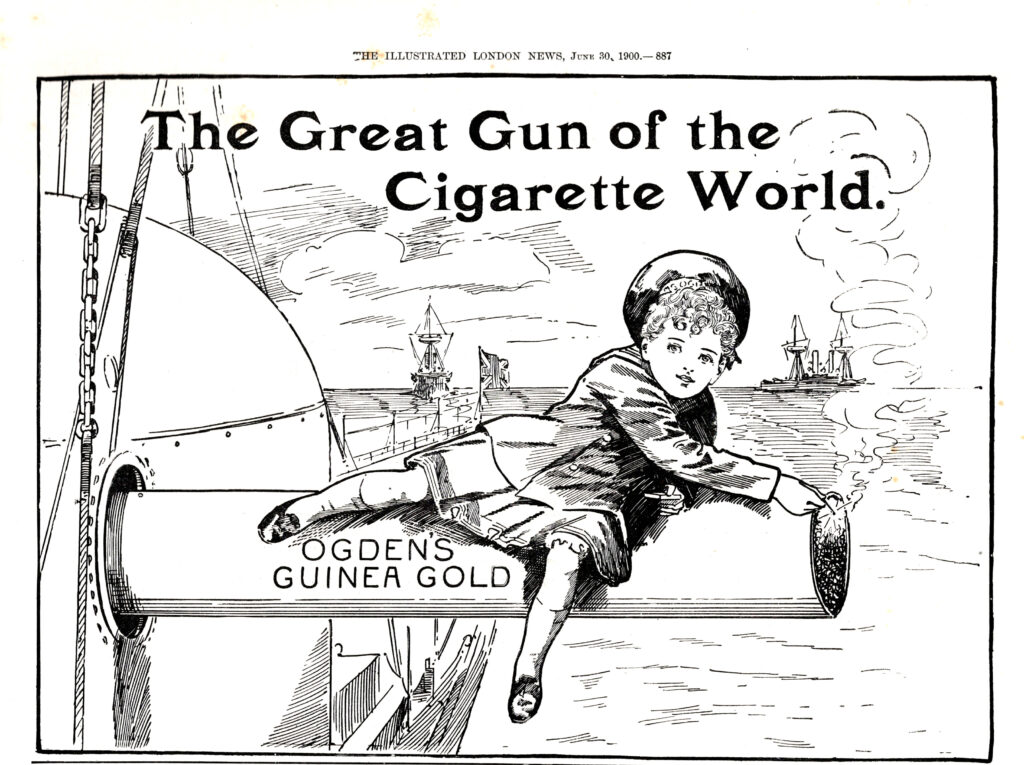
Published ILN June 30, 1900 (p.887)
Of all the adverts in this campaign, this is probably the most disturbing and alien to 21st Century thinking. Whatever British military performance on land, reassuringly there was always the mighty iron-clad and naval superiority to fall back on. Obviously intended to be a light-hearted celebration – hopefully the Fleet was armed with more than a huge cigarette – presumably the child doing his bit for Queen and Country symbolises the future to be secured? The fact the skirted poppet has escaped his aristocratic Nursery and Nanny’s beady eye suggests an unappealing cunning. Frankly how he comes to be at sea, playing with matches and about to light a giant Ogden’s Guinea Gold makes one question the artist’s choice of inhaled stimulant. Nor does it fit comfortably into Ogden’s series of ‘amusing’ infant interactions with incompetent parent published 26 January and 18 May 1901 and 21 June 1902. It remains plain weird.
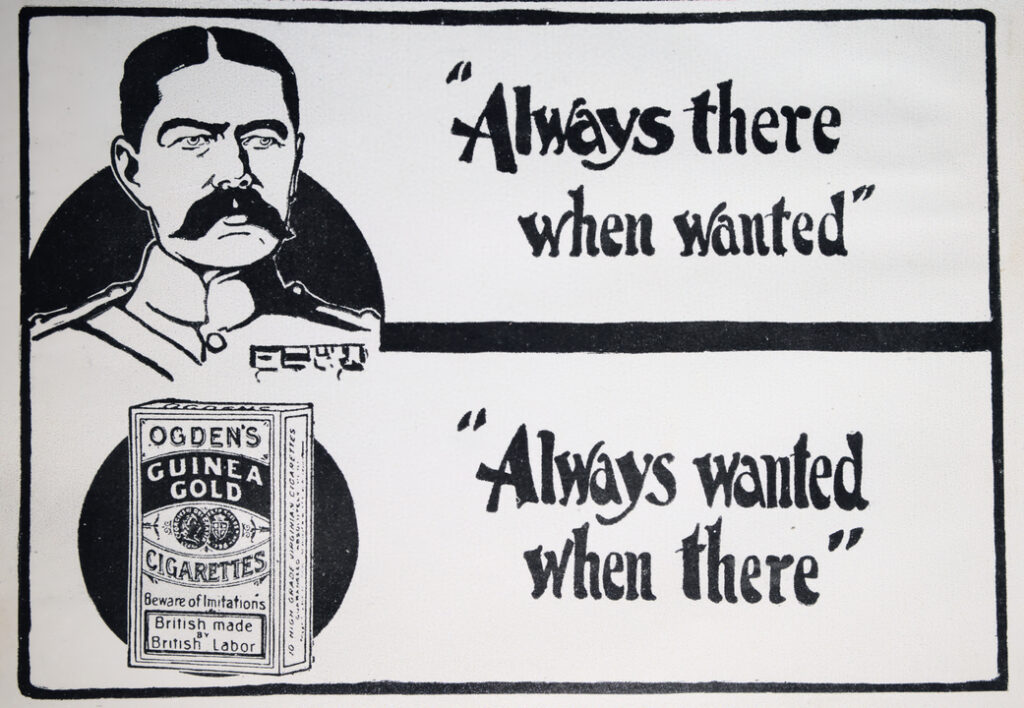
ILN March 9, 1901 (p.359)
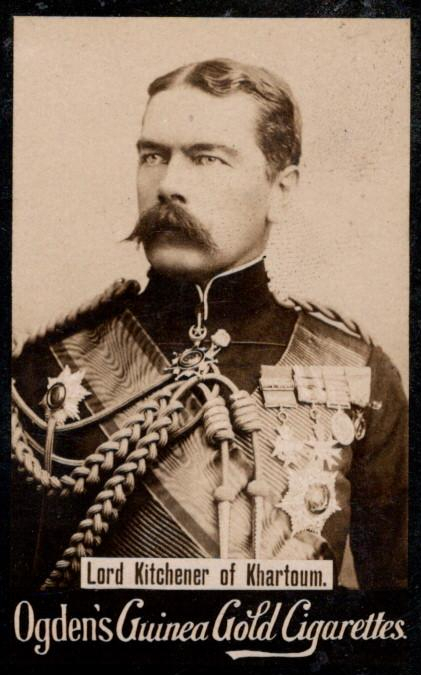
Throughout Ogden’s Boer War advertising there are foretastes of images today associated with the First World War. Perhaps the most striking, and eerie, of these is Kitchener’s appearance anticipating his modern association as the face of First World War recruitment, however erroneously. The accompanying Ogden’s Guinea Gold cigarette card is a more traditional view.
The final South African reference appeared in June 1901. This rather mundane photograph of Ogden’s crates being unloaded at Durban appears more a piece of photo-realistic journalism than advertisement.
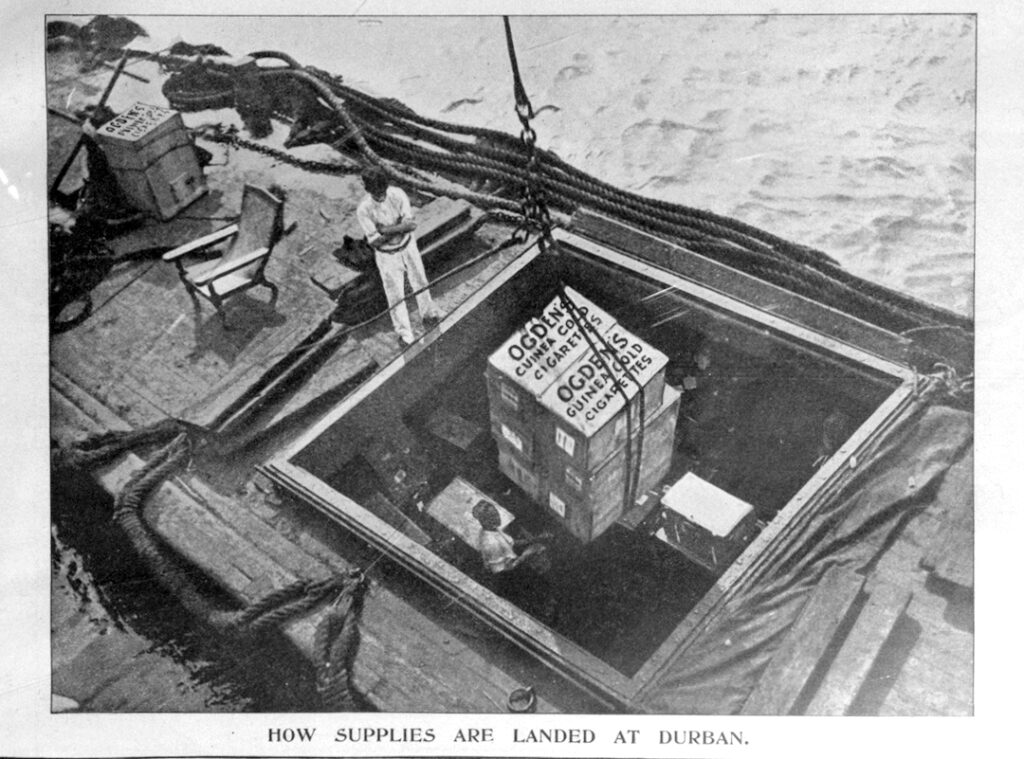
BC
Nov 6, 2023

